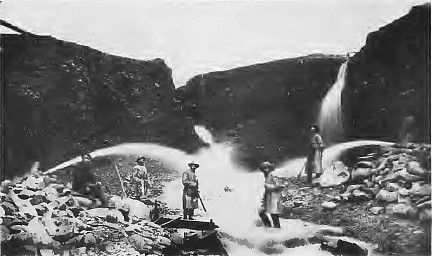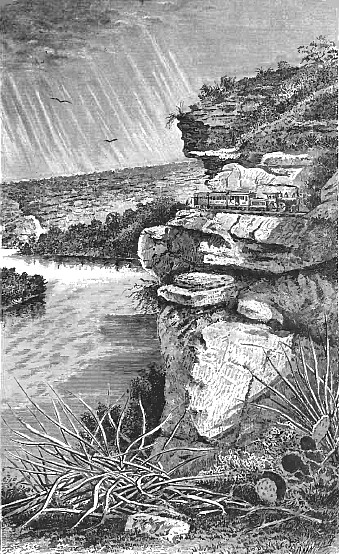Up to 1862, little was known of Central Arizona, its mines, its forests, and its agricultural possibilities. It was the home of the Apache, the most treacherous and dangerous of all the Indian tribes. The first expedition to explore this section of the country was known as the "Walker Party." Captain Joseph P. Walker, who commanded the expedition, was an old hunter and trapper. In 1837, and 1838, in company with Jack Ralston, who later died, he discovered in this part of the country a metal which, years afterwards when visiting San Francisco, he found to be native gold. In 1861, Walker desiring to explore this country for the yellow metal, organized in Kernville, Kern County, California, a company for that purpose.
The following are the names of the members of that company; Captain Joseph R. Walker, Joseph R. Walker, Jr., John Walker, John H. Dickson, George Lount, George Cutler, Tarsith, Clothier, John I. Miller, J. L. Miller, Samuel C. Miller, George Blasser, Col. Harding, Felix Buxton, Albert Dunn, Martin Lewis, Jacob Lynn and Luther Paine. Their objective point was the country in and around Prescott and the Little Colorado . After crossing the Colorado, they were continually harassed by Indians, which prevented them from exploring the country to the south as they had intended. The San Francisco Mountain was their landmark and passing around its base, they followed up the Little Colorado, but failing to find gold, they pursued their journey eastward, and reached New Mexico that same year. Upon reaching New Mexico, the party maintained its existence and enlisted under "Kit" Carson against the Indians. Captain Walker retained his rank and the original number of fighting men under him. In 1862, the party went to Colorado, and in the Fall of that year, another expedition was set on foot with the Hassayampa as the objective point.
Thirty-four hardy _ and intrepid men signed the muster-roll, with a full determination to blaze the trail for others to follow. The names and nativity of the men composing this expedition are as follows Captain Joseph R. Walker, Tennessee; Joseph R. Walker, Jr., Tennessee; Martin Lewis, Missouri; Jacob Lynn, Missouri; Charles Noble, Missouri; Henry Miller, Missouri; Thomas Johnson, Missouri; George Blasser, Pennsylvania; Alfred Shupp, Pennsylvania; John J. Miller, North Carolina; Jacob Miller, Illinois; Sam. C. Miller, Illinois; Solomon Shoup, Illinois; Hiram Cummings, New Hampshire; Hiram Mealman, New Hampshire ; Wm. Wheelhouse, New York; George Coulter, New York; John "Bull," England; George Lount, Canada; Rhoderic McKinney, Canada; Bill Williams, Massachusetts; A. C. Benedict, Connecticut; A. French, Vermont; Jacob Schneider, Germany; John Dixon, Mississippi ; Frank Finney, Louisiana ; John Young, Kansas ; Jackson McCracken, South Carolina; John W. Swilling, Georgia; Chase, Ohio; Felix Buxton, France; Chas. Taylor, Sailor ; F. G. Gilliland, Kentucky, Daniel E. Conner, Kentucky. In September, 1862, the company left Pueblo, Colorado, and being regarded with some suspicion, the authorities thinking they might be seeking to effect a junction with the Confederates, General Carleton employed A. C. Benedict to accompany the expedition for the purpose of watching its movements and reporting the same. The party went south to what afterwards became known as Fort West, and stopped a short time, at that place, during the Winter of 1862-63, where Jack Swilling and Jackson McCracken joined them. Jack Swilling, as we have seen, had served under Captain Hunter when the Confederates captured Tucson, and commanded the little detachment that killed Lieutenant Barrett of the Federal army, in the engagement near the Picacho. While at Fort West, the party served the Government under the command of Captain McCleve. Leaving this place, they followed the old Butterfield trail for some distance but branched off from it to explore the unknown wilderness in the north, from one hundred and fifty miles to two hundred miles distant.
This was the first invasion of Arizona by any organized body of white men, and was the beginning of the end of Apache dominion in that section of the Territory of Arizona. Crossing the great Gila Desert from Sacaton Station, now known as Oatman Flat, on the River Gila below the Pima Indian Villages, the Walker party reached the wooded territory in and around Prescott, and there made a final stand for a new base of operations. They felled the trees and built a corral in a hollow square that the savages could not break through, in which their sixty head of mules were kept during the night. For nearly a year previously, six men were required to guard the stock constantly, day and night; it only required one man to guard the corral. This change, inaugurated by Captain Walker, was very satisfactory, but the party were here stored away, or rather, secreted in a nook in the wilderness, unknown to any of their race, and it became necessary to notify the outside world where they were located, so it was decided to make a flying trip to the Pima Villages on the River Gila.
A hole was dug into which all their supplies and equipage was cached, and the party went south with their mules to get a full supply of pinole and other foodstuffs from the friendly Pimas, with whom they left letters to go eastwardly and westwardly by any stray party of soldiers that might pass through the Villages during the next six months. These letters described the locality and situation in the previously unknown woodland, in which the party had decided to make their final stand. The return trip was made without accident, the party arriving at their new home after an absence of twenty days. Preparing to do business with the Apaches, they strengthened their corral, and constructed a large log cabin, or fort, beside it for protection against their Apache foes, and for shelter from the storms, as the rainy season had begun in earnest. This corral and log cabin were built on the Hassayampa about five miles from the present location of the city of Prescott.
From this point, parties went out in all directions prospecting. Early in May, 1863, Sam Miller and four others went up Lynx Creek. Here while some of the party went hunting, Miller went over to a bank nearby, and washed a pan of dirt, from which he got $4.80. Word was sent to the main camp on the Hassaympa of the rich find. The party broke camp and moved on to Lynx Creek, where they worked successfully in placer mining and trapping. A miner's meeting was organized, and Thomas Johnson was selected for president, after Captain Walker had declined, and William Wheelhouse for recorder. This was the first mining district ever organized in Central Arizona, and it was located about five miles south of the present city of Prescott on the north bank of the Hassayampa, and these were the first white men to locate in this part of the country, and with the abundance of gold they washed out, and the number of Indians they killed, they experienced, says Mr. Fish, what some termed a booming gold rush time.
From this period, newcomers came from all directions, settling down with the Walker pioneers, in and around what afterwards became Prescott. The Walker party was dissolved in 1864, and some of its members afterwards became identified with the early history of the Territory of Arizona. The history of this expedition has been written by Daniel E. Conner, the last survivor of the party, and I hope the State of Arizona will secure it, as it gives a succinct and continuous narrative of the expedition of the Walker party, which was the first to enter Central Arizona, the vanguard of that army of pioneers which subsequently reclaimed this rich and fertile country from savage dominion. The success of these pioneers is largely to be attributed to Captain Walker; he understood the Indian character well, and while his policy toward them was never brutal, but humane, yet he was always ready to meet them in battle, when such a policy was necessary and could not be avoided. Patient and prudent, conservative, and cautious, enjoying the full confidence of his followers, the campaign, in every way, was a successful one.
The glowing reports spread by the members of the command of Captain Pishon upon their return, of the rich gold mines in the vicinity of the Hassayampa, and Lynx Creek, and around the headwaters of the streams in that vicinity, did much to attract attention to that region. Several parties were hurriedly organized to prospect in the new El Dorado. Jim Shelby, of Santa Fe, fitted out five teams loaded with provisions, groceries, etc., and left Santa Fe for the gold fields in October, 1863. There were with him Frank Shaffer, Louis St. James, Billy Foster, Frank Riggs, John Justice, Tom Barnum and others. In a short time there was a second party on the way, which consisted of Rufus E. Farrington, W. C. Collins, Lew Alters, Ed. G. Peck, and Lon Thrift.
Return
to The Arizona Page:
Arizona Gold Rush Mining History



